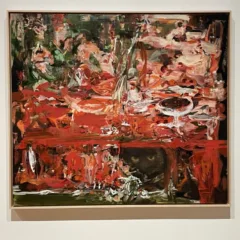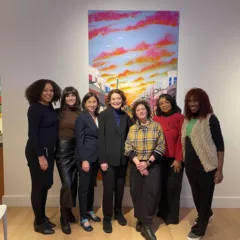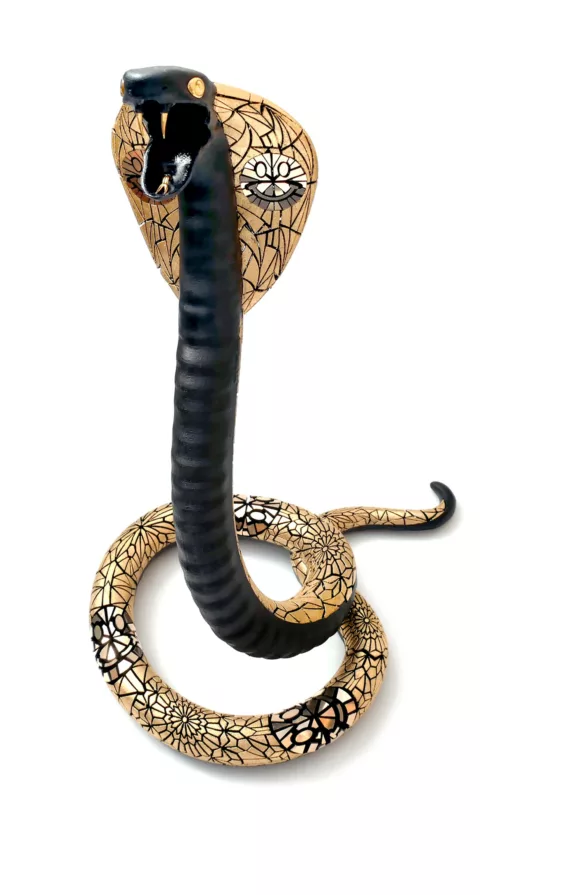
“Ssssmiley Face,” a life-size, 3D printed black cobra, embellished with gold leaf mosaic patterning, greets visitors to the Woodmere Art Museum’s 81st Annual Juried Exhibition. Walk around to the back of the piece, and the pattern on its flared hood resolves into the titular two eyes and a grin. It’s a dazzling and winking welcome to a juried exhibition whose call to Philadelphia-based artists was to submit works on the theme of finding “novel and infinite ideas and methods of connection.” You’ll find multiple kinds of connections evident in “Ssssmiley Face.”The piece was a collaboration between Mallory Weston and Emily Cobb, who created it by mailing it back and forth across the country. And like a number of pieces in this sprawling exhibit of 54 artists, the tabletop sculpture blurs the boundaries between design, ornament, jewelry and sculpture, and combines traditional and innovative methods of production. There’s a very good reason for that, and his name is Doug Bucci.
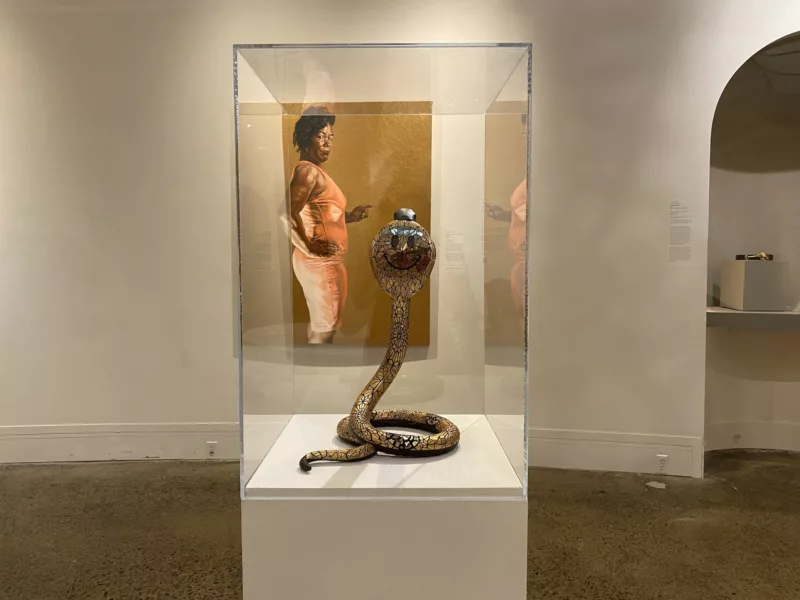
Bucci is this year’s juror. In addition to providing the theme or concept for the exhibition and selecting works, Woodmere Annual Exhibition jurors are asked to include their own work in the exhibition. Making connections and crossing disciplines is at the core of Doug Bucci’s work. He uses innovative 3D modeling and printing techniques to transform medical information into everyday objects such as jewelry and dinnerware. Bucci, a diabetic, collects streams of data from the continuous glucose monitoring system he wears. The information is transmitted to 3D modeling software and then transformed into visualizations of the data. One of Bucci’s works in the exhibition that uses this methodology is the stunning piece, “Islet | White Sectional, Neckpiece.” It’s both elegant and whimsical in appearance. Open honeycomb-patterned tubes bend and twist seamlessly, creating a chain with links that swell in size, as gravity weighs it down. How about that for statement jewelry?
Bucci is also an educator. He is an assistant professor and the program head of Temple’s Tyler School of Art and Architecture Metals/Jewelry/CAD-CAM department.
It’s a treat to see a wider range of objects than you usually find in group shows, and it’s exciting to be introduced to new types of craftsmanship. The exhibition feels like an encouraging nudge toward the kinds of exchanges we had before lockdown. In the exhibition catalog, Bucci said he “wanted a call that was broad but very much of and about Philadelphia in the larger sense.” What we get through his considered selection of works is a celebration of the place and people, shown through explorations of traditional and inventive artistic processes.
I found surprising connections between very different works in the exhibition. Several have an ephemeral quality. One striking example is Kathleen Greco’s “In Lieu of Flowers / Carnations.” The materials are listed as “Flower petals, paper.” An ethereal patch of Barbie-pink striations hovers on the paper. Its visual impact evoking both delicacy and boldness, with a wry nod at minimalist and monochromatic traditions. Its conceptual depth unfolds with the title, material and process of creation and raises questions. Are petal pigments fugitive or archival? What compels someone to rub carnation petals over and over? In the context of the 19th century Woodmere mansion, it’s easy to make a connection to Victorians’ use of flowers to convey coded messages.
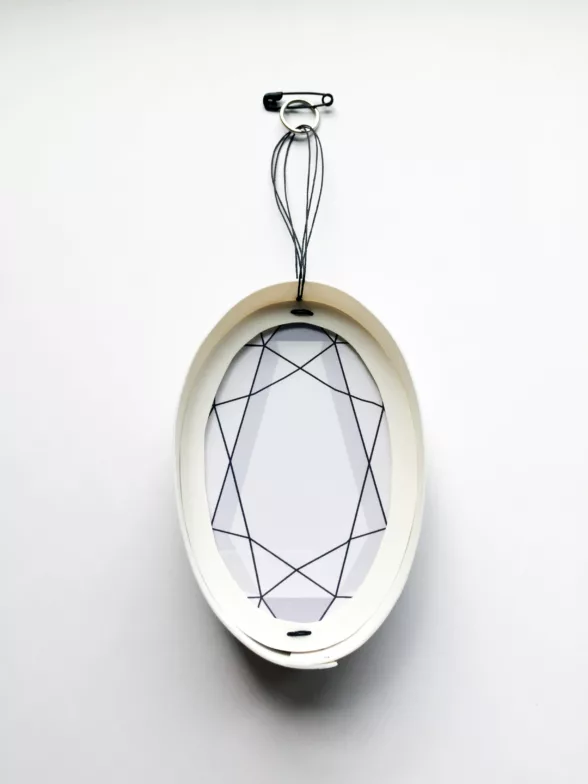
At first glance, “Upcycled Reimagined Gemstone Object No. 1” by Patricia Sullivan has a makeshift, temporary appearance, like that of a mockup, but the piece is much more. Its materials are listed as “Upcycled fibrous material, thread, and digital drawing.” This charming and deceptively complex work questions assumptions and expectations about materials, commerce and preciousness, while making us surrender to the seduction of simple geometry.
Elizabeth Hamilton’s “Derby Plate I and II” from her “Private Collection” series is a playful homage and critique of opulence. Applying watercolor and acrylic gold paint to paper plates, Hamilton faithfully reproduces the floral motifs of porcelainware held in the Philadelphia Museum of Art’s collection.
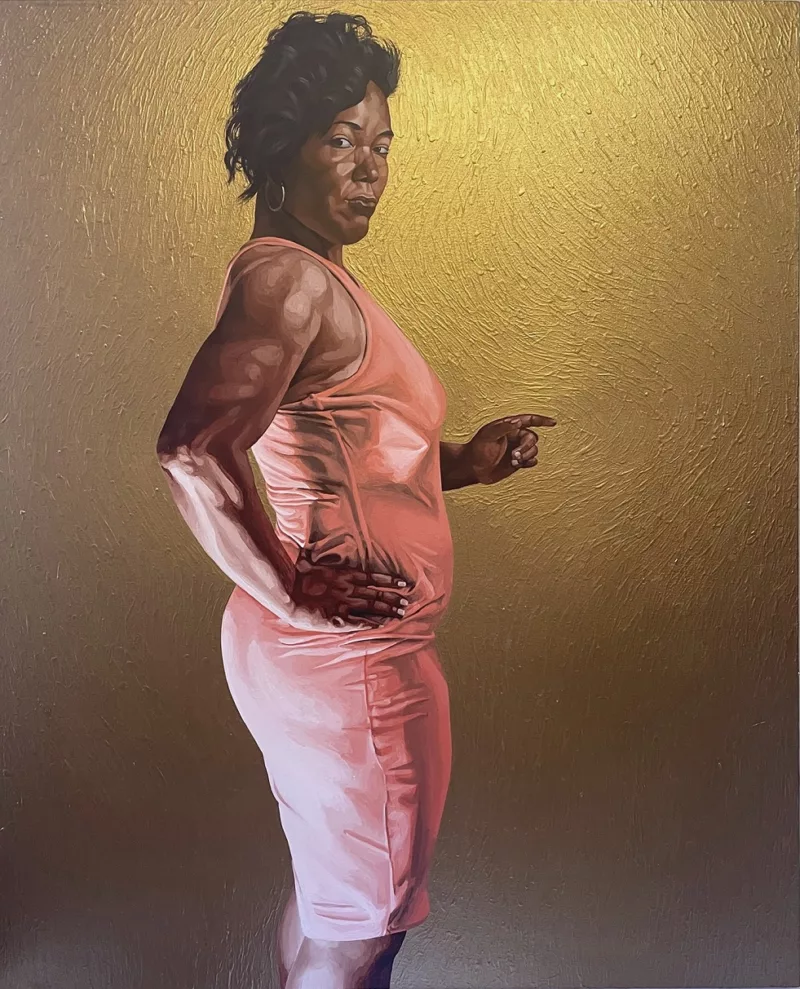
Speaking of gold, Cavin Jones uses the precious metal as a transcendent background in his painting “Nothing Like You Has Ever Been Seen Before” from the series “Gold.” The subject’s direct gaze and confident stance are reinforced by brushwork that bends and swirls around the pointing figure, showing the model’s power to affect her environment.
I noticed several works that connect to water in surprising ways. A sweet family moment is captured in Sarah Kaufman’s photograph, “Devil’s Pool Bathers #9.”
Gordon Stillman collaborated with the elements to create “Unfolded Boat.” The 22” x 30” paper was coated with a sun-sensitive cyanotype solution then set afloat to develop in water. The framed, flattened rectangle with varying shades of blue triangles and squares records the non-linear story of the work’s voyage as a paper boat.
Marguerita Hagan’s ceramic piece, “Flourish,” is a wonder of close observation and homage to diatoms, the microscopic organisms that live in water singly or in colonies. Hagan, whose work is also currently on view in the group show, WACK!, at HOT BED, created her own colony of diatoms arranged in the form of a flower. White ovoid and circular forms are pierced and marked with a variety of patterns then arranged like petals around a central disk. She gives us a bouquet of these invisible neighbors for us to marvel at and appreciate.
The exhibit is a great showcase for our human neighbors who draw, paint, print, cast, salvage linoleum, electroform copper, recycle paper, crochet, use computer aided-design, and many more techniques to communicate.
The Woodmere Annual 81st Juried Exhibition runs from June 3 – August 27, 2023.


